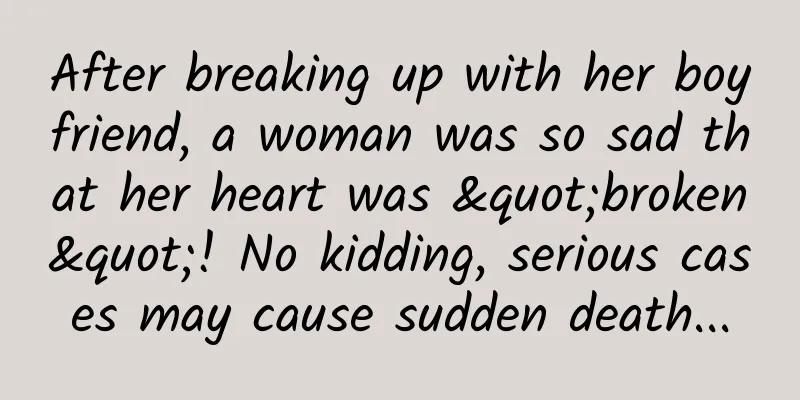After breaking up with her boyfriend, a woman was so sad that her heart was "broken"! No kidding, serious cases may cause sudden death...

|
Expert in this article: Yang Chao, MD, attending physician at the Rocket Force Special Medical Center Reviewer of this article: Chen Haixu, Deputy Director and Master Supervisor of the Second Medical Center of PLA General Hospital "It's so sad, my heart is broken..." Many people often say this when they encounter sad things, often because they feel sad and depressed because of something. But have you ever thought that when you are sad to a certain extent, you may really be "heartbroken". Recently, a woman was very sad after breaking up with her boyfriend. Unexpectedly, she developed chest pain, shortness of breath and other symptoms. After seeing a doctor, the doctor said that the woman's condition was called "broken heart syndrome." Weibo screenshot What is Broken Heart Syndrome? Is the heart really broken? Read on. What is Broken Heart Syndrome? In real life, emotions not only affect people's thinking, but also affect our heart structure. When exposed to great stress such as car accidents, shock, excessive sadness, fear and physical illness, the left ventricle will experience transient segmental myocardial contraction disorders, which we call "broken heart syndrome", also known as stress cardiomyopathy, apical balloon syndrome, Takotsubo syndrome, and octopus pot cardiomyopathy. It was first proposed by Japanese scholar Sato in 1990. Broken heart syndrome is an acute syndrome characterized by transient localized left ventricular systolic dysfunction caused by physical or psychological stress. 17.4 people out of every 100,000 suffer from broken heart syndrome, which is more common in postmenopausal women. The average incidence rate in women is 7.5 times that in men. What are the symptoms of Broken Heart Syndrome? The hearts of patients with broken heart syndrome usually do not have obvious organic lesions such as vascular obstruction, so their hearts are not really "broken", but their signs and symptoms are often similar to those of a heart attack. Doctors generally make a diagnosis through personal medical history and physical examination, electrocardiogram (ECG), echocardiogram, blood myocardial enzyme testing, cardiac magnetic resonance imaging (MRI), coronary angiography and other examinations. Copyright image, no permission to reprint The initial symptoms of broken heart syndrome are similar to those of acute coronary syndrome, generally manifested as severe pain behind the sternum, pressure in the chest area, palpitations, syncope, etc. The symptoms will disappear in most patients within a few weeks. Severe patients may experience pulmonary edema, arrhythmia, or even cardiogenic shock, such as hypotension, cold limbs, dyspnea, and electrocardiogram ST segment changes, but there is no angiographic evidence of obstructive coronary artery disease, and coronary stent placement or surgical bypass surgery is not required. A small number of patients may experience cardiac arrest, respiratory arrest, and sudden death. A study in the Journal of the American Heart Association showed that "broken heart syndrome" not only damages the heart, but may also cause cancer. What factors may trigger broken heart syndrome? ● Emotional stressors: death or injury of relatives or friends, violent quarrels, property loss, legal proceedings, car accidents, etc. ● Physical stressors: severe illness, surgery, severe pain, recovery from general anesthesia, hyperthyroidism, cocaine abuse, etc. Copyright image, no permission to reprint How is Broken Heart Syndrome Treated? There is currently no unified standard treatment for stress cardiomyopathy. The symptoms of broken heart syndrome are similar to those of acute coronary syndrome. Before a clear diagnosis is made, it can be treated according to the treatment of acute coronary syndrome. After the diagnosis is confirmed, the inducing factors should be removed and stress factors should be avoided. The underlying disease should be actively treated and symptomatic supportive treatment should be given. Most patients have a good prognosis and recover within a few days to a few weeks. A few can last for more than 3 months. The in-hospital mortality rate is less than 8%. When we encounter sad things Learn to self-coach Or seek help from others Beware of Broken Heart Syndrome If you experience any discomfort Seek medical attention promptly The cover of this article and the pictures with watermarks in the text are from the copyright library and are not authorized for reproduction |
<<: [Fat Bear Science] Watermelon, grapes, peaches... How to eat summer fruits
Recommend
[Health Lecture] Stop sneezing with "spring" and say goodbye to allergic rhinitis
1. What is allergic rhinitis Allergic rhinitis (A...
If you are hungry at midnight during pregnancy, it is a boy
During pregnancy, many pregnant women feel hungry...
Chicken soup for pregnant women
Everyone knows that old hen soup is very nutritio...
Ten questions and answers about COVID-19 "re-positivity" and "reinfection"!
Source: People's Daily WeChat...
Unpleasant smell of discharge
In real life, it is a very common condition that ...
Asthma: A “misunderstood” disease
Asthma is a common respiratory disease, but it is...
How long after sex can I use a test strip to detect pregnancy
Couples who are preparing for pregnancy all hope ...
What should I do if my menstrual period is not clean for one month?
All women experience menstruation, but some women...
In order to cure this disease, he went to court
Author's note: In the elementary school Chine...
Girls fingertips numb
Some girls may easily find their fingertips numb....
What should I do if there are small itchy bumps on my labia?
Female friends often suffer from some gynecologic...
Why can't celery leaves be eaten (contains bitter ingredients, low water content and tastes bad)
...
Ovulation period conception boy girl
Although it is already the 21st century, we can s...
What are the reasons why menstruation is delayed for 10 days?
Nowadays, many women have gynecological diseases,...









